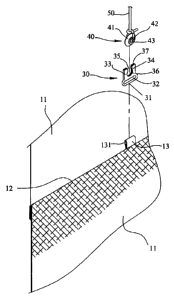Note: Claims are shown in the official language in which they were submitted.
THE EMBODIMENTS OF THE INVENTION IN WHICH AN EXCLUSIVE
PROPERTY OR PRIVILEGE IS CLAIMED ARE DEFINED AS FOLLOWS:
1. A Roman shade comprising:
a top box;
a shade composed of a fabric sheet and a top end of the shade connected to the
top box and multiple pocket portions formed along a first side of the shade,
the pocket
portions each being defined by folding upward a part of the fabric sheet and
fixing the
part along a folding line, each pocket portion defining a passage which
extends
transversely through the shade, rods extending through the passages, multiple
loop
members connected to each of the folding lines;
the loop members located at the lower end of the shade each connected with
an engaging member and each engaging member including two claws extending
therefrom in the same direction, a through hole defined between the two claws
and an
opening located between the two claws and communicating with the through hole,
each
claw including a slit defined axially in a distal end thereof;
two control ropes each having a first end connected to the top box and a
second end of each of the two control ropes extending through the loop
members;
two insertion members connected to the two respective second ends of the two
control ropes, the insertion members inserted into the slits of the two claws
via the
openings and engaged with the through holes, the claws clamping the insertion
members to position the insertion members between the two claws, when the
control
11
ropes are pulled beyond a clamping force applied to the insertion members, the
insertion members are disengaged from the slits and the through holes of the
two claws.
2. The Roman shade as claimed in claim 1, wherein each of the engaging
members includes a connection portion which has an elongate slot, the elongate
slot of
the connection portion of each of the engaging members is connected to one of
the loop
members.
3. The Roman shade as claimed in claim 1, wherein each of the two claws of
each of the engaging members includes a stop extending inward from an inside
thereof,
the opening is defined between the two stops and the through hole is defined
between
the insides of the two claws and the stops, the slit is defined in the distal
end of each
claw and the stop of each of the claws.
4. The Roman shade as claimed in claim 1, wherein the engaging members are
made of plastic material.
5. The Roman shade as claimed in claim 1, wherein the engaging members are
made of metallic material.
6. The Roman shade as claimed in claim 1, wherein each of the insertion
members is a ring-shaped member and includes a ramp portion on two sides
thereof and
a passage is defined through each of the insertion members, an annular lip
extends from
a periphery of the passage and is engaged with a periphery of the through hole
of the
engaging member.
12
7. The Roman shade as claimed in claim 1, wherein each of the insertion
members is made of plastic material.
8. The Roman shade as claimed in claim 1, wherein multiple restriction
members are connected to the loop members except for the loop members
connected
with the engaging members, each restriction member including a ring, a bent
first
extension and a bent second extension are connected to the ring, a gap is
defined
between the first and second extensions, a restriction hole is defined between
the first
and second extensions and communicates with the gap, the control rope extends
through the restriction hole.
9. The Roman shade as claimed in claim 8, wherein the bent first extension
and the bent second extension have a conjunction end which is fixed to the
ring and
extend across each other to define the restriction hole.
10. A Roman shade comprising:
a top box;
a shade having a top end thereof connected to the top box and multiple
restriction members connected to the top box, each restriction member
connected to an
engaging member which has two claws extending therefrom in the same direction,
a
through hole defined between the two claws and an opening located between the
two
claws and communicating with the through hole, each claw includes a slit
defined
axially in a distal end thereof, and
13
two control ropes each having a first end connected to the shade and a second
end of each of the two control ropes connected to an insertion member which is
inserted
into the opening and engaged with the through hole of the engaging member
corresponding to the control rope, when the control ropes are pulled beyond a
clamping
force applied to the insertion members, the insertion members are disengaged
from the
slits and the through holes of the two claws.
11. The Roman shade as claimed in claim 10, wherein each of the two claws
of each of the engaging members includes a stop extending inward from an
inside
thereof, the opening is defined between the two stops and the through hole is
defined
between the insides of the two claws and the stops, the slit is defined in the
distal end of
each claw and the stop of each of the claws.
12. The Roman shade as claimed in claim 10, wherein each of the insertion
members is a ring-shaped member and includes a ramp portion on two sides
thereof and
a passage is defined through each of the insertion members, an annular lip
extends from
a periphery of the passage and is engaged with a periphery of the through hole
of the
engaging member.
14
